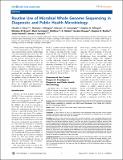Files in this item
Routine use of microbial whole genome sequencing in diagnostic and public health microbiology
Item metadata
| dc.contributor.author | Koeser, Claudio U. | |
| dc.contributor.author | Ellington, Matthew J. | |
| dc.contributor.author | Cartwright, Edward J. P. | |
| dc.contributor.author | Gillespie, Stephen H. | |
| dc.contributor.author | Brown, Nicholas M. | |
| dc.contributor.author | Farrington, Mark | |
| dc.contributor.author | Holden, Matthew T. G. | |
| dc.contributor.author | Dougan, Gordon | |
| dc.contributor.author | Bentley, Stephen D. | |
| dc.contributor.author | Parkhill, Julian | |
| dc.contributor.author | Peacock, Sharon J. | |
| dc.date.accessioned | 2012-12-14T10:31:01Z | |
| dc.date.available | 2012-12-14T10:31:01Z | |
| dc.date.issued | 2012-08-02 | |
| dc.identifier | 41247430 | |
| dc.identifier | 218ecadd-edfc-4e7f-8787-6a38d303f9f9 | |
| dc.identifier | 000308558000008 | |
| dc.identifier | 84866148001 | |
| dc.identifier.citation | Koeser , C U , Ellington , M J , Cartwright , E J P , Gillespie , S H , Brown , N M , Farrington , M , Holden , M T G , Dougan , G , Bentley , S D , Parkhill , J & Peacock , S J 2012 , ' Routine use of microbial whole genome sequencing in diagnostic and public health microbiology ' , PLoS Pathogens , vol. 8 , no. 8 , e1002824 . https://doi.org/10.1371/journal.ppat.1002824 | en |
| dc.identifier.issn | 1553-7374 | |
| dc.identifier.other | ORCID: /0000-0001-6537-7712/work/39477856 | |
| dc.identifier.uri | https://hdl.handle.net/10023/3290 | |
| dc.description | This work is partly supported by funding from the Medical Research Council, the European Developing Country Clinical Trials Partnership, the Global Alliance for TB Drug Development, and the European Union. | en |
| dc.description.abstract | Whole genome sequencing (WGS) promises to be transformative for the practice of clinical microbiology, and the rapidly falling cost and turnaround time mean that this will become a viable technology in diagnostic and reference laboratories in the near future. The objective of this article is to consider at a very practical level where, in the context of a modern diagnostic microbiology laboratory, WGS might be cost-effective compared to current alternatives. We propose that molecular epidemiology performed for surveillance and outbreak investigation and genotypic antimicrobial susceptibility testing for microbes that are difficult to grow represent the most immediate areas for application of WGS, and discuss the technical and infrastructure requirements for this to be implemented. | |
| dc.format.extent | 9 | |
| dc.format.extent | 323519 | |
| dc.language.iso | eng | |
| dc.relation.ispartof | PLoS Pathogens | en |
| dc.subject | RA0421 Public health. Hygiene. Preventive Medicine | en |
| dc.subject | QR Microbiology | en |
| dc.subject | SDG 3 - Good Health and Well-being | en |
| dc.subject.lcc | RA0421 | en |
| dc.subject.lcc | QR | en |
| dc.title | Routine use of microbial whole genome sequencing in diagnostic and public health microbiology | en |
| dc.type | Journal item | en |
| dc.contributor.institution | University of St Andrews. School of Medicine | en |
| dc.contributor.institution | University of St Andrews. Biomedical Sciences Research Complex | en |
| dc.contributor.institution | University of St Andrews. Gillespie Group | en |
| dc.contributor.institution | University of St Andrews. Global Health Implementation Group | en |
| dc.contributor.institution | University of St Andrews. Infection Group | en |
| dc.identifier.doi | https://doi.org/10.1371/journal.ppat.1002824 | |
| dc.description.status | Peer reviewed | en |
This item appears in the following Collection(s)
Items in the St Andrews Research Repository are protected by copyright, with all rights reserved, unless otherwise indicated.

